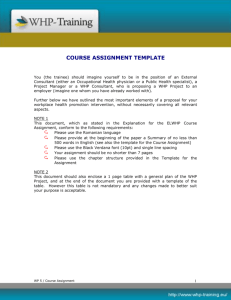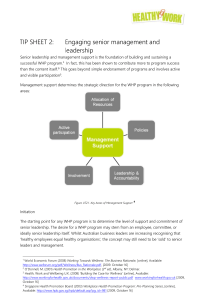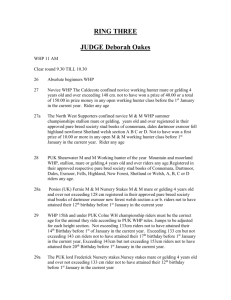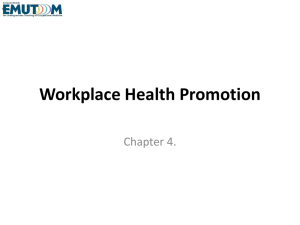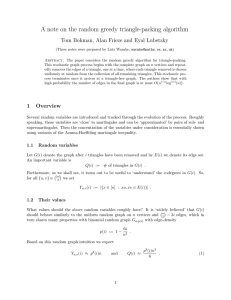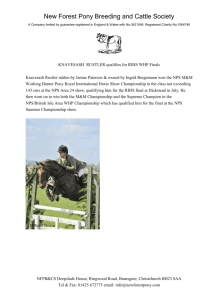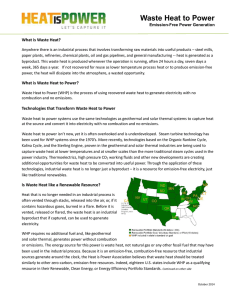WHP writing policy - Oakland University
advertisement
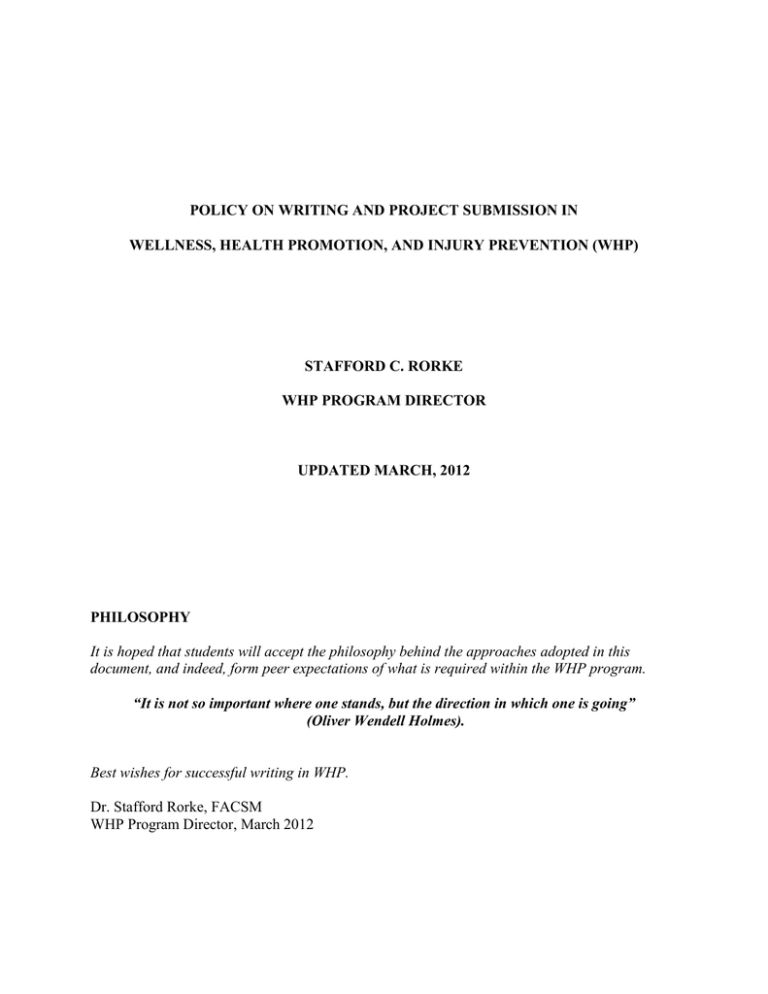
POLICY ON WRITING AND PROJECT SUBMISSION IN WELLNESS, HEALTH PROMOTION, AND INJURY PREVENTION (WHP) STAFFORD C. RORKE WHP PROGRAM DIRECTOR UPDATED MARCH, 2012 PHILOSOPHY It is hoped that students will accept the philosophy behind the approaches adopted in this document, and indeed, form peer expectations of what is required within the WHP program. “It is not so important where one stands, but the direction in which one is going” (Oliver Wendell Holmes). Best wishes for successful writing in WHP. Dr. Stafford Rorke, FACSM WHP Program Director, March 2012 2 POLICY ON WRITING AND PROJECT SUBMISSION IN WHP SUBMISSION OF WRITTEN WORK It is a requirement that every WHP student adhere to this policy. All written work must be typed and submitted in the form outlined below. Minor variations occur depending on the type of assignment. For example, an Abstract is not always required, and chapter formatting is not always required. However, all other formatting such as headings, sub-headings, left justification and referencing requirements apply to all submissions. Title page format A title page is required when submitting all assignments or project work for any WHP course and/or when submitting any document to a professor for any purpose. The rationale is that in business, a document is never submitted unless under cover of a title page; for example, an explanatory cover page should be sent with a FAX, a cover letter should accompany a resume when applying for a job. The format for all submissions must appear fully as in the sample title page box below, specifically: All writing is centered; Title in all capitals, bold; Submitted by (name of student author); In partial fulfillment of (state full name of course); For (state name of professor); followed by the due date. If there is no specified due date then the date of submission must be stated. PREVENTION OF VIOLENCE: “KONY2012” AND THE ABUSE OF CHILD SOLDIERS Submitted by Leonard C. Rorke In partial fulfilment of the requirements of WHP 310 (4): Injury Prevention and Control For: Dr. Stafford C. Rorke Due Date: March 20, 2012 3 General assignment outline All papers must be structured with appropriate headings and sub-headings. Papers should follow scientific format (where appropriate) of: Abstract (summary); Introduction, Literature Review; Methods; Results (including Tables and Figures); Discussion; Conclusion and Recommendation; References; Appendices. As seen throughout this document - a double line space must precede major headings that must be in all capitals bold, whereas the first letter of a sub-heading must be in capitals, bold and indented. The first word in a paragraph is not indented; however, quotes exceeding three lines are indented. Academic conduct and plagiarism WHP students are expected to produce individual, unaided, original work (unless informed otherwise, for example when doing group projects). Students are expected to be familiar with Oakland University Academic Conduct Regulations (2011-): “All members of the academic community at Oakland University are expected to practice and uphold standards of academic integrity and honesty. Academic integrity means representing oneself and one’s work honestly. Misrepresentation is cheating since it means students are claiming credit for ideas or work not actually theirs and are thereby seeking a grade that is not actually earned. Following are some examples of academic dishonesty: 1. Cheating on examinations. This includes using materials such as books and/or notes when not authorized by the instructor, copying from someone else’s paper, helping someone else copy work, substituting another’s work as one’s own, theft of exam copies, or other forms of misconduct on exams. 2. Plagiarizing the work of others. Plagiarism is using someone else’s work or ideas without giving that person credit; by doing this, students are, in effect, claiming credit for someone else’s thinking. Whether students have read or heard the information used, they must document the source of information. When dealing with written sources, a clear distinction should be made between quotations (which reproduce information from the source word-for-word within quotation marks) and paraphrases (which digest the source of information and produce it in the student’s own words). Both direct quotations and paraphrases must be documented. Even if students rephrase, condense or select from another person’s work, the ideas are still the other person’s, and failure to give credit constitutes misrepresentation of the student’s actual work and plagiarism of another’s ideas. Buying a paper or using information from the World Wide Web or Internet without attribution and handing it in as one’s own work is plagiarism. 3. Cheating on lab reports by falsifying data or submitting data not based on the student’s own work. 4. Falsifying records or providing misinformation regarding one’s credentials. 4 5. Unauthorized collaboration on computer assignments and unauthorized access to and use of computer programs, including modifying computer files created by others and representing that work as one’s own. Unless they specifically indicate otherwise, instructors expect individual, unaided work on homework assignments, exams, lab reports and computer exercises, and documentation of sources when used. If instructors assign a special project other than or in addition to exams, such as a research paper, or original essay or a book review, they intend that work to be completed for that course only. Students must not submit work completed for a course taken in the past or for a concurrent course unless they have explicit permission to do so from both faculty members.” Plagiarism is a serious academic offence: Potential consequences for plagiarizing may include: Academic disciplinary warning Academic probation Suspension Expulsion (dismissal) from the university Withdraw grades may be changed to the appropriate numerical grade Students are required to acquaint themselves with the nature of plagiarism and methods of avoiding plagiarism. See http://library.oakland.edu/tutorials/studentplaghandout2008.pdf . RESEARCH PAPERS The following expectations exist for submission of all written research work in the WHP Program: An abstract An abstract should be written in all cases where scientific writing applies and when stipulated as a requirement by the professor. If a student is unsure about whether an abstract is required then the student should ask the professor. An abstract is the first thing seen by the reader after the title page. Students usually have difficulty writing an abstract because in many cases students think the abstract is merely an introduction. However, an abstract is more than an introduction. Although written as a single paragraph of approximately 150-250 words, an abstract is a synopsis (summary) of the complete paper in question and appears on a separate page. There are usually no references cited in an abstract and while the abstract does appear first in the paper, it is often best to write the abstract last, after the assignment/paper is complete. There is an exception to an abstract, namely the “Executive Summary,” as discussed below. 5 An executive summary An “Executive Summary” (ES) differs from an abstract in several ways. First, the use of an ES is usually in the business world, rather than a scientific application. An obvious example would be a report to a Chief Executive Officer (CEO). In most cases a CEO has little time to read a full report. Consequently, an ES is a one to two page summary of the document, and may appear in short paragraph and bullet point form. See the example listed as Appendix A in this document. DETAILED WRITING REQUIREMENTS The following pages address detailed format and referencing requirements. In particular, students should note the page, headings, paragraph, labeling, sequencing layouts, plus in-text referencing citation format and reference list format. 6 CHAPTER ONE INTRODUCTION DETAILED WRITING STRUCTURE IN WHP Students of the WHP program are expected to be excellent readers and writers. A person reading and comprehending the material throughout this document will note that the major headings are written in a specific manner and follow a particular format structure. This structure is required in WHP. The “Chapter” or topic heading is in all capital letters, bold font and centered in the middle of the page. Each chapter of a major report starts on a new page; but, do note that the chapter format is not required for all papers. However, even when chapter format is not required in an assignment, it is still a requirement to have major and sub-headings throughout any assignment or paper. All writing is left justified. A double line space follows before the subject-specific major heading that is also in all capitals, bold font. Readers will note that after a major heading there is a single line space before the paragraph begins and the first word of the paragraph is not indented. At the end of a paragraph an additional single line space is left before the indented sub-heading e.g. see “Pagination and Contents” below. An additional observation is that text is not written in the first or second person, something that should be avoided in scientific writing. Pagination and contents The document should be paginated with the page numbers appearing on the top or bottom right of the document. There is no page number on the title page. If the document is lengthy then a “Contents” page should also be provided. The contents page appears after the Abstract, and the contents page should list in order: Chapters; List of Tables; List of Figures; Reference page; and finally, List of Appendices. This “list” is only a list of the headings in the paper together with the page number. Actual Tables or Figures are not placed in the list. The “front pages” consisting of Abstract and Contents are numbered in Roman numerals, i, ii, iii, iv and so forth. Page one (1) of a lengthy document begins at Chapter One. Note that for shorter assignment submissions there would only be a title page followed by the necessary assignment, without need for “front pages.” Attention to detail Irrespective of final career choice, excellent writing will be a requirement in the workplace. However, most students fail to attend to the level of detail outlined in this document. For example, a reminder that the sub-heading above is indented, the first letter is a capital letter, the remaining letters are lower case, and the words are in bold font. The first word of the paragraph is not indented and the paragraphs are all left justified. Note too that “WORD” spellcheckers do not check spelling for capitalized headings. Therefore, before submission, proofreading of all written work is expected of WHP students. 7 Tense and colloquial language All writing must be in past tense, unless a proposal is being written. Colloquial, conversational language is to be avoided (e.g. do not use “like;” instead use “such as”); plus, first and second person speech (I, me we, they, them and so forth) is not acceptable. CITING REFERENCES IN THE TEXT References must be cited in the text using a modification of the APA system (author, date), for example: Single author: The energy cost ratio for concentric to eccentric work is 3:1 (Rorke, 1993). Note the placement of the comma and end of sentence period. The reference is part of the sentence; therefore the period is after the reference (not placed before the reference). Two authors: Rorke and Rorke (2002) advocate task-specific physical readiness evaluations (PREs) for those engaged in physically demanding occupations. Multiple authors: Blair et al. (2002) argue that physical inactivity is the number one public health challenge facing the USA today. Or; Physical inactivity is the number one public health challenge facing the USA today (Blair et al., 2002). Note that unlike APA where the first citation lists multiple authors, for any source where there are more than two authors, in WHP immediate use is made of et al. For a direct statement from an authority/person: According to Andress (2005) the conceptual model used by the WHP Program is highly advanced and is usually only found at the graduate program level. Note: Such statements must be used sparingly and usually only in the case of an important direct statement/quote; for example a statement made by a prominent visiting scholar. Use the last name of the author only and year. Direct quotes from written sources: Should be avoided, and used sparingly. If used, the page number must be given for a direct quote, thus: Cooper said “get fit” (Cooper 2000, p98). Note: Author, year, page number, in that order. If a direct quote exceeds 3 lines the must be indented (see section above on academic conduct and plagiarism). Internet references: Must be used sparingly, and if used, every attempt must be made to establish the name of the author or editor. If the name of the author/editor cannot be found then the name of the organization must be used. Note that the title of the paper is never used for in-text referencing; and a URL link is never used in the text. 8 Which organization to cite in the text? The Centers for Disease Control (CDC) is the umbrella body for many sub-agencies, such as the National Center for Health Statistics (NCHS) or Healthy People 2020. The correct reference to cite is the primary agency/source, not the umbrella agency. In other words, in the examples above the NCHS (2012) or Healthy People 2020 (2011) would be used. See below for how to cite Internet References in the Reference list. Same author has published multiple articles/papers in the same year: Colvin (2012a) reported increasing protests by citizens in Syria. Colvin (2012b) reports government military attacks on defenseless civilians in Homs, Syria. Before her untimely death, Colvin (2012c) was appalled at the lack of international intervention to protect defenseless citizens in Syria. Note that in the reference list each separate citation must appear as a separate reference. Do not use in-text citations or reference author initials, titles or affiliations with organizations. In other words, the following is unacceptable: Dr. Pink Blue Toothbrush (2012) from the Dentists Against Tooth Decay Agency advocates twice a day mouthwash as well as brushing teeth three times as day. Correct use is author last name and year: Toothbrush (2012) advocates……. Students must conduct a PubMed, Ovid, MEDLINE, SPORT DISCUS or other library data base search before using any Internet sources. For students seeking assistance with conducting a through and efficient literature search, the librarians at the Kresge Library are an invaluable resource. REFERENCES (list) After the assignment Conclusion (and before any Appendices) a Reference list must be attached to all written project work, under a major heading: REFERENCES, as above. The titles “Works Cited” and/or Bibliography may not be used. Every reference cited in the text must appear in the Reference list, and every Reference cited in the list must be used in the text of the paper. The reference list is presented in alphabetical order and each reference is written in the following manner: For journal articles: Gledhill, N. and Jamnik, V.K., (1992) Development and validation of a fitness screening protocol for firefighter applicants. Canadian Journal of Sport Sciences 17(3), 199-206. For books Thibodeau, G.A. and Patton, K.T (2002) The human body in health and disease. Third Edition. Mosby, Philadelphia. 9 For a citation in a book: Haddon, W., Jr., (1970) On the escape of tigers: An ecological note. In: Mohan, D. and Tiwari, G., Editors, (2000) Injury Prevention and Control. Taylor and Francis, New York. For proceedings: Greenhorn, D.R., Stevenson, J.M. and Deakin, J.M., (1996) Gender-fair selection Tests: legislative, procedural and biomechanical factors. Proceedings of the Canadian Society for Biomechanics IXth Biennial Conference, Burnaby, British Columbia, 330-331. For an Internet Reference: Healthy People 2010 (2000) Injury and violence prevention. Centers for Disease Control and Prevention. Available at: http://www.healthypeople.gov/document/HTML/Volume2/15Injury.htm Accessed on August 8, 2003. [Students must provide complete URL, not merely the Home Page URL]. For a direct statement from an authority/person: Andress, W.C. (2005) Personal Communication. Address to WHP Student Society, September 2005, Oakland University, Rochester Michigan, USA. For the same author who has published more than one paper in the same year: As for the appropriate reference method above, list the author, initials, year and full details of each reference - but for each reference use the following notation for the year: (2012a), (2012b) and (2012c). NOTE ON UNACCEPTABLE WRITING AND REFERENCING PRACTICES “Cutting and pasting” is unacceptable. Paraphrase and give credit to the original author. Verbatim use of Tables and Figures by photocopying is unacceptable (this infringes copyright because author and/or publisher permission is required). However, selective use is acceptable if the material is clearly referenced and placed as an Appendix only. In most cases, such Tables and Figures should not appear in the text (body) of the writing. 10 TABLES AND FIGURES IN THE TEXT A table is used to present data in the form of rows and columns, whereas a figure is a graphic, image or picture. Presenting a table within the text Tables must have a heading above the Table, numbered in Roman numerals followed by a description e.g. Table I: Heart Rate (HR) and Ratings of Perceived Exertion (RPE) for males and females during treadmill walking at 3 miles.hr-1. GENDER Male Female HR 125 133 RPE 12 13 Presenting a Figure within the text Figures must have a caption below the Figure numbered in Arabic numerals e.g. Paffenbarger R et al. 1984, Clinics in Sports Medicine, 3 (2) p. 306. heart attack % reduction in risk of first 0 Risk of first time heart attack was 39% less in people expending more than 84000 kJ.week-1. Other activities Vigorous sports 100 4000 8000 12 000 16 000 20 000 Leisure time energy expenditure (kJ.week-1) Figure 1: Risk of first time heart attack versus energy expenditure (Paffenbarger et al., 1984). 11 FURTHER IMPORTANT CONSIDERATIONS WHEN WRITING IN WHP Definitions/abbreviations: The first time an abbreviation is used in the text it must be defined e.g. Heart rate (HR) increases linearly when exposed to linear increases in workloads on a treadmill. Numbers in the sentence: Do not start sentences with numbers or percentages e.g. 21 subjects took part; 40% of all US children are obese. Write the word in full i.e. Twenty-one subjects … Forty percent… No numbers followed by numbers: Do not write a number followed by a number because such a sentence is difficult to read; for example: In 2006, 800,000 people were victims of human trafficking (Cooper, 2007). Rewrite the sentence: In 2006, there were 800,000 victims of human trafficking (Cooper, 2007); or: In 2006 eight hundred thousand (800,000) people were victims of human trafficking (Cooper, 2007); or: According to Cooper (2007) in 2006 the number human trafficking victims was 800,000. No colloquial language: Do not use colloquial language or trite expressions such as everyday speech or slang. No first/second person speech: Avoid all first and second person conversational writing i.e. use of “I,” “me,” “you,” “your, they, them.” Avoid vague terms at the beginning of a sentence: Avoid “it, this, that.” Be specific. Define precisely what is meant by “it, this or that” etc. Spellcheck and proofread: All work must be spell-checked and proofed for grammar. If writing English as a second language it must be language corrected. Business e-mail communication/writing: A business e-mail without a heading and grammatical correct message plus clear identification of the sender is inappropriate. In high risk times for computer virus infections such Emails are immediately deleted if both the Email address and subject are not recognized. Students should remember this in future and not be surprised if they fail to receive a reply from a professor if the proper form is not followed. Singular versus plural and grammar: Singular “is” and plural “are.” Blair (2006) is correct in his assertion that ….. Cooper et al., (2010) are of the opinion…. (Despite any potential dumb and erroneous “flags” by Word!). Datum versus data: Datum is singular and data are plural. Therefore, sentences must be correctly phrased e.g. …. and these data suggest..... Font and size: Times New Roman 12 point is recommended. APPENDICES Any material that would interfere with ease of reading should be attached as an Appendix at the end of the document (after the Reference list) and labelled as Appendix A, B, C etc, with a description. Note the difference between a single Appendix, and multiple Appendices (plural). See examples of Appendices A and B, below. 12 PRESENTATION OF WRITTEN WORK AT CONFERENCES, SYMPOSIA OR ANY OTHER VENUE All written material presented at conferences, symposia or other venues must have a statement to the effect that the work arises from the WHP Program. Full credit must be given by referencing the Wellness, Health Promotion and Injury Prevention Program in the title of the work. Unless stipulated otherwise by a faculty member, secondary authorship must be given to the faculty member under whose direction the written work took place. Usually the last name listed in the title will be that of the faculty member. The suggested format is as appears below: TITLE IN BOLD (ALL CAPITALS, CENTERED) Name, middle initial, last name of author/s (bold, centered) Wellness, Health Promotion, and Injury Prevention Program School of Health Sciences Oakland University (bold, centered) ADDITIONAL WRITING EXPECTATIONS FOR WHP 401 AND 402 Students should be aware of the following with respect to writing expectations in WHP 401 and WHP 402: There is an expectation in the SCE that students draw on composite knowledge gained in several undergraduate courses e.g. research methods, WHP 300/305, WHP 350/360 etc. and that such knowledge is clearly demonstrated. Do not “compartmentalize” knowledge i.e. form an opinion/belief that knowledge gained in one course only applies to that course and does not extend to other courses/projects. Writing that does not conform to WHP guidelines and does not demonstrate what has previously been learned will be rejected e.g. written in the first person, incomplete sentences, no headings/sub-headings and/or indented paragraphs. The proposal and written report The proposal and final written project for WHP 402 must be submitted in the form of a research paper or report and as such usually contain five critical chapters, namely: Chapter One: Introduction [should include a statement of the problem, hypothesis, delimitations (scope, confines, boundary of the study) and limitations]. Chapter Two: Literature Review. 13 Chapter Three: Methods (subjects, study/project design, measured variables, equipment, protocols, pilot testing, data analysis, as applicable). Chapter Four: Results and Discussion (findings and interpretation of results). Chapter Five: Conclusions and Recommendations. After the chapter content the Reference list is added, and finally, any Appendices. Attention to detail The WHP 402 proposal: Whether or not a research project is being done, the proposal must be written in such a manner that each of the above five Chapters is introduced. The introduction should state a hypothesis i.e. what findings are anticipated? There should be a brief literature review related to the program. However, it is the Methods chapter that is most critical. Students should attend to: A statement of where the research/project will be conducted, the name and contact details of the responsible site supervisor, expected number, ages and gender of subjects, anticipated procedures, methods, informed consent (must be provided for research projects), testretest methods, details of the intervention, statistical methods for test-retest results etc., if appropriate, timelines, and expected outcomes. If the proposal is well written it is easily edited later to form part of the final report. If working with human subjects students must submit an application to the Institutional Review Board (IRB) at Oakland University via the RAM system. Students cannot begin advertising, recruiting subjects or collecting data prior to approval by the IRB. The review process takes anywhere from one to three months; therefore, students should consider these time constraints when compiling a timeline in their WHP 402 proposal. Students need to review the guidelines at: http://www2.oakland.edu/research/research2/compliance.cfm?mi=7&hi=3&ID=1 The final report: This document is written in scientific language and in past tense with no first or second person writing. There must also be a Reference list and Appendices. ADDITIONAL EXPECTATIONS OF STUDENTS IN THE WHP PROGRAM Several very important additional expectations exist for every student in the WHP program, irrespective of whether the student is doing the minor or major. There is an expectation that students will read, comprehend and adhere to these expectations outlined in Appendix B below and on the WHP webpage, as amended from time to time. Experience has taught professors that having high expectations of students is in the best interest of students. CONCLUSION The mission of professors in WHP is to prepare students for meaningful work, fulfilling lives and responsible citizenship. We want students to succeed. Following the guidelines in this document will enhance the chances of success. Students ignore the guidelines at their own peril. 14 APPENDIX A SAMPLE EXECUTIVE SUMMARY EXECUTIVE SUMMARY Purpose: The feasibility of a unique, new interdisciplinary baccalaureate degree in Wellness, Health Promotion and Injury Prevention is presented (see Concept Document, page iii). Wellness: Defined as optimum physical, emotional, spiritual, social, intellectual, occupational, and environmental health. Rationale: Healthy People 2010, (2000): This U.S. Department of Health and Human Services report highlights the need for national interventions in wellness and health promotion. Leading causes of morbidity and mortality in the United States, including Michigan, are largely preventable. Health, wellness and injury prevention is a topical area of focus for academic enquiry. Inter-disciplinary education of specialists in wellness will meet future needs for practitioners. Proposed New Degree: Unique Major in Wellness, Health Promotion, and Injury Prevention, plus a Minor. Conveys knowledge in all domains of wellness. Meets goals and objectives of Healthy People 2010, (2000). Conveys behavior-change skills and health promotion competencies. Designed with six specialization tracks: - General Health Enhancement - Complementary Medicine - Exercise Science - Interventions in Wellness - Injury Prevention - Pre-professional Minors possible with this major: Human Resource Development, Psychology, Sociology, Anthropology, Industrial Safety, Exercise Science, Teachable Minor in Health Education. Enables entry into graduate study programs: Public health, psychology, counseling, human resource development, ergonomics, industrial health and safety, exercise science, education, medicine, dentistry, chiropractic, physician assistant, and executive MBA. Oakland University Resources and Strengths: Programs and faculty: Health sciences, business, education and human services, psychology. Superb facilities and student service programs. Leadership status in Southeast Michigan. 15 Opportunities and Challenges: A Michigan first - a unique interdisciplinary degree that will attract new students to Oakland. A “We Care” program theme in wellness that would include student health-risk appraisals. Provision of adequate resources to facilitate the new degree. Allocation of appropriate student services center to coordinate health-risk appraisals. Prospective Student Interest: High among high school, admitted and current students. Sufficient interest to justify the commencement of the proposed degree. Interest justifies student intake numbers used in the resource analysis. Occupational Outlook and Employment Opportunities: Sustained growth and demand for skills in traditional and newly emerging job categories. Demand for entry-level employees is projected to rise substantially in selected sectors. Overall job market projected to show a slight increase in demand for entry-level employees. Job opportunities are considerably enhanced with an additional Minor program of study. Prospective Employer Support: Substantial support for the proposed program was forthcoming. Eclectic, interdisciplinary approach to curriculum design is considered a degree strength. Business acumen, internships, generic and practical skills are considered strengths. Support from National Associations: Inter alia: Office of the Secretary of the Department of Health and Human Services. President of the American College of Sports Medicine. The nation’s leading wellness program at the University of Wisconsin Steven’s Point. New Resources and Economic Viability The proposed degree is economically viable. After provision for appropriate new resources the program is projected to yield a profit in the third year. Conclusions and Recommendations: It is considered feasible to proceed with the proposed baccalaureate degree in wellness. Oakland University should approve the proposed degree without delay. Oakland University should approve faculty and facility resources to manage this program. Oakland University should implement the additional recommendations of the report. 16 APPENDIX B ADDITIONAL EXPECTATIONS OF STUDENTS IN THE WHP PROGRAM EXPECTATIONS TO ENSURE SUCCESS IN WHP A number of program expectations exist, including the requirement to maintain a grade point of 2.5 in all SHS courses, undertake a health risk appraisal (HRA), maintain a journal for all WHP courses, graduate with superior communication skills, as well as other expectations. The expectations for the HRA, journal, attendance, and communication skills are discussed. The general policy applies to students in both the WHP minor or major. ATTENDANCE, TARDINESS, DEADLINES, APPEARANCE AND LANGUAGE USAGE Attendance, tardiness, appearance, and language usage are potential “bones of contention” and relate directly to personal “marketability” and chance of success in the job market. In the best interests of WHP students there are high expectations that students succeed and are to be considered superior and “in demand” relative to their counterparts in the field. Consequently, there is an expectation in the program of: 1. High attendance rates. Attendance at the first class of every semester is a program requirement. Students should plan personal lives accordingly, and not, for example, plan a holiday or extended long weekend before the start of a semester. Students not attending class on the first day will be dropped from the class to facilitate entry of students on waitlists. Attendance will be monitored in all classes and grades will be negatively impacted if classes are missed without a legitimate reason. Students will be placed on early probation if attendance is deemed to be a problem. The same will apply to tardiness (punctuality). Late coming is frowned upon. The WHP program has been designed with several practical hands-on courses. Missed course work cannot be compensated for by reading a textbook, and will negatively affect job skill acquisition. 2. Personal presentation: While there is no formal “dress-code” there is an expectation that Wellness, Health Promotion, and Injury Prevention students “stand out from the crowd” as professionals, in appearance, dress, deportment and ability to communicate. The WHP faculty will encourage aboveaverage dress at every opportunity. We feel appearance is a form of non-verbal communication and is an important aspect of future job success. While we do not wish to mandate a dress code, three examples of when this will be a strong expectation are: During WHP 305 laboratories; during in-class presentations; and, at the exit interview (for majors). Students will be evaluated at superior levels of expectation, for example, such as giving a public address to an important target audience, acting as a clinician in the laboratory, or in the case of the exit interview, as if at a job interview. 3. Cell-phone policy: Cell-phones/IPODS must be switched off and may not be visible in class or during an examination. No text messaging is permitted during class. Calls must be avoided during class breaks if the call is likely to disrupt prompt return to the classroom. 17 4. Deadlines: It is a program expectation that students consistently meet assignment and project deadline dates. No excuses will be entertained. Accountability and responsibility are the key words. In the “real world” missed deadlines may mean loss of a job or business opportunity. Students who fail to meet deadlines will encounter severely reduced grades. All evaluation components must be completed for each course, failing which an I-grade is awarded. 5. Language use: Colloquial and everyday language bordering on slang will be discouraged. Use of words such as “like,” “gotcha,” “butt,” and “tons” of other examples “like, you know,” together with culturally sensitive language, will be politely pointed out to students with the goal to improve communication skills. This will extend to the use of the telephone and e-mail. 6. WHP Student Society: Involvement with the WHP Student Society and volunteering for other campus activities: Such involvement is strongly encouraged in order to get to know professors and peers. In addition, these activities increase student and program visibility on campus. For the individual student there are often benefits at a later stage when a student applies to graduate school or for work, and a professor is asked to write a reference. HEALTH RISK APPRAISAL (HRA) It is a program requirement for all students to undertake a health risk appraisal in the program of study. This process will be directly facilitated in the laboratory course WHP 305. Further information will be supplied in that course. WHP STUDENT JOURNAL/PORTFOLIO: AN IMPORTANT WHP 402 REQUIREMENT It is a requirement for evaluation in the WHP 402 senior culminating experience class (SCE), that students keep a journal record of all WHP coursework throughout the WHP academic program. Inclusion of other major program work e.g. exercise science, psychology or human resources, is optional. Expectations for the journal Place a copy of all WHP course syllabi, a copy of any major project work undertaken for any WHP course, and a brief, self-reflection about each WHP course experience into the journal/portfolio (binder?) for submission at the end of your program (during the SCE class). The purpose of the journal is to assist you to find work following graduation. A well-documented record of coursework taken, together with samples of practical WHP applications, will demonstrate evidence of student knowledge, skills and abilities.
